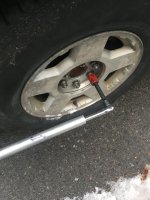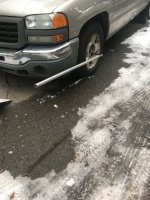This seizing up started a couple of years ago. Twice a year the wheels get removed for the summer/winter tire switch. This seizing was not happening during the previous fourteen years of I switching the wheels on this truck, nor did it happen with my previous vehicles. Coincidentally it started at the same time I started using an air impact for initial tightening of the nuts, prior to the final hand tightening with a torque wrench. I overtorqued some of the nuts at this time because some of them did not turn further with the torque wrench. They were not grossly overtightened and the nuts still turned on the studs without binding afterwards. This is the Aircat gun I used
Happens with both genuine GM alloy rims (summer tires) and the OE steel rims (winter tires). Lug nuts are GM OE. Threads are clean and I do not apply any lubricant except for a small drop of oil on the cone face of the nut where it mates with the rim. I initally tighten the lug nuts to about 80 ft lbs, lower the truck to the ground and then use a torque wrench and tighten the lug nuts diagonally to the GM recommended 140 ft lbs. There is no binding when running the nuts on to the studs, indicating no distortion of the threads on the nuts and studs. Very little rust on the nuts and studs.
Wheel is stud piloted. Studs are 14 x 1.5 mm. It is like there is some micro welding happening because after applying about 300 ft lbs to break the nuts loose, it gives way suddenly and then comes off easily. It is not the case where you spin the nut loose a tiny bit and then the torque required drops to 250 ft lbs and so on. There is no progressive drop in torque as the nut is loosened.
The aluminium cheater pipe in the photo is four feet long, that is what it took the break the nuts loose.
Happens with both genuine GM alloy rims (summer tires) and the OE steel rims (winter tires). Lug nuts are GM OE. Threads are clean and I do not apply any lubricant except for a small drop of oil on the cone face of the nut where it mates with the rim. I initally tighten the lug nuts to about 80 ft lbs, lower the truck to the ground and then use a torque wrench and tighten the lug nuts diagonally to the GM recommended 140 ft lbs. There is no binding when running the nuts on to the studs, indicating no distortion of the threads on the nuts and studs. Very little rust on the nuts and studs.
Wheel is stud piloted. Studs are 14 x 1.5 mm. It is like there is some micro welding happening because after applying about 300 ft lbs to break the nuts loose, it gives way suddenly and then comes off easily. It is not the case where you spin the nut loose a tiny bit and then the torque required drops to 250 ft lbs and so on. There is no progressive drop in torque as the nut is loosened.
The aluminium cheater pipe in the photo is four feet long, that is what it took the break the nuts loose.


